Creating a stunning, water-wise landscape is easier than you think! Explore 23 updated drought-tolerant landscape designs for 2025. These ideas will help you conserve water and enhance your outdoor living spaces. Discover native plants and innovative hardscaping techniques. Build a sustainable and beautiful garden that’s both functional and visually appealing.
Incorporating Hardscapes to Reduce Water Needs

In 2025, drought-resistant landscape design emphasizes hardscapes for water conservation. The photo showcases a curved path built with stone pavers, bordered by thoughtfully selected indigenous plants. This combination enhances visual appeal and significantly reduces irrigation needs.
Employing stones and gravel significantly minimizes soil erosion. It also enhances rainwater absorption into the earth. This pathway encourages exploration of the scenery. It ensures minimal upkeep and reduced water consumption. Succulents and drought-tolerant shrubs perfectly enhance the hardscape. They thrive with minimal watering.
Designing outdoor spaces with patios, walkways, and rock gardens enhances beauty. These features minimize water-intensive grass. Select appropriate materials and plants for a drought-resistant landscape. This approach creates a visually appealing and sustainable environment.
Incorporating Native Plants for Drought Resistance

Using native plants in your garden boosts its ability to withstand dry spells. This picture displays a stunning mix of native flora, showing off their different forms and hues. These plants thrive in local weather and need less watering than foreign plants.
Observe the vibrant purple blooms rising gracefully from the lush green leaves. These plants enhance visual beauty and draw in native pollinators, benefiting the local environment. Mulch application aids in soil moisture retention, promoting the healthy development of drought-resistant species.
Choose native plants adapted to your local climate. Their deep roots efficiently tap into underground water sources. This adaptation enables them to endure extended dry spells. They are a superb option for eco-friendly landscaping in 2025.
Native plants offer excellent drought resistance, leading to low-maintenance gardens. Choose wisely to create a lively landscape. You’ll save water and help local wildlife thrive.
Utilizing Mulch to Conserve Soil Moisture

Mulch is a straightforward, powerful way to conserve soil moisture in water-wise gardens. The picture showcases lush green plants nestled within a bed of natural mulch. This combination is visually appealing and highly functional.
Mulching helps your soil retain moisture, so you water less often. This protective layer slows evaporation and keeps roots cool. Plus, it stops weeds from growing, which steal water and nutrients from your plants.
Mulch is key to a sustainable, drought-tolerant garden. It boosts plant health and saves precious water. Combine mulch with drought-resistant plants, as shown, for a beautiful, low-water landscape that flourishes.
Choosing Perennial Plants for Longevity
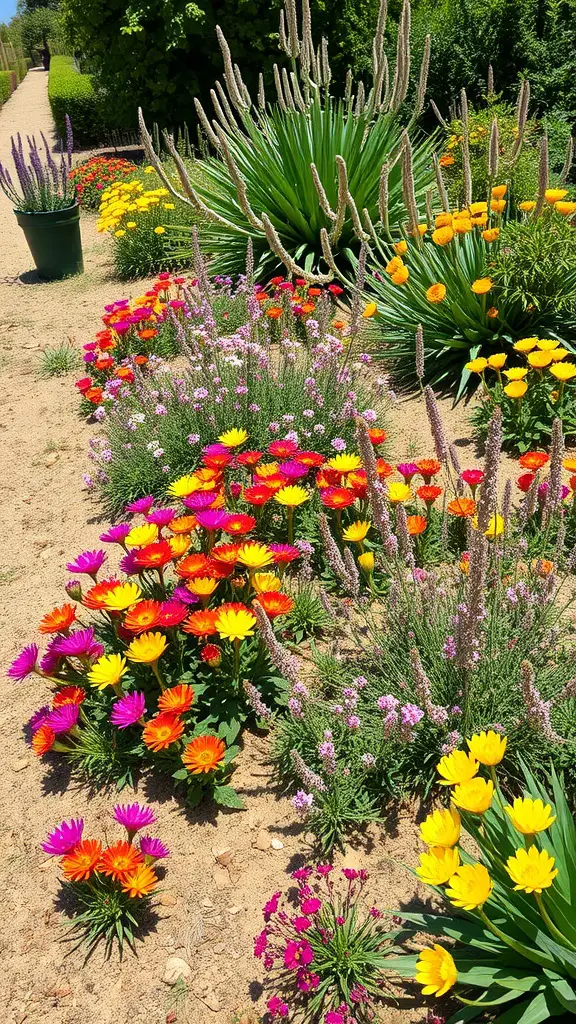
Crafting a drought-resistant garden? Choosing the perfect perennial plants is essential for a thriving, year-round display. This image showcases a vibrant array of flowers and foliage, all flourishing in arid environments.
Vibrant yellows, reds, and purples paint the landscape with life. These colors captivate the eye and draw in vital pollinators. These plants thrive in low-water environments. They are perfect for regions prone to drought.
Perennials are a fantastic choice for any garden! Unlike annuals, they bloom annually, reducing upkeep and saving you valuable time. This image highlights several varieties that thrive in hot conditions while maintaining their beauty. When choosing your plants, prioritize those known for their hardiness and drought tolerance.
Adding plants like these results in a beautiful, easy-care garden. Plus, it’s good for the environment! When planning your garden, consider the lasting advantages of drought-tolerant perennials. They flourish with very little water.
Implementing Rain Gardens for Stormwater Management
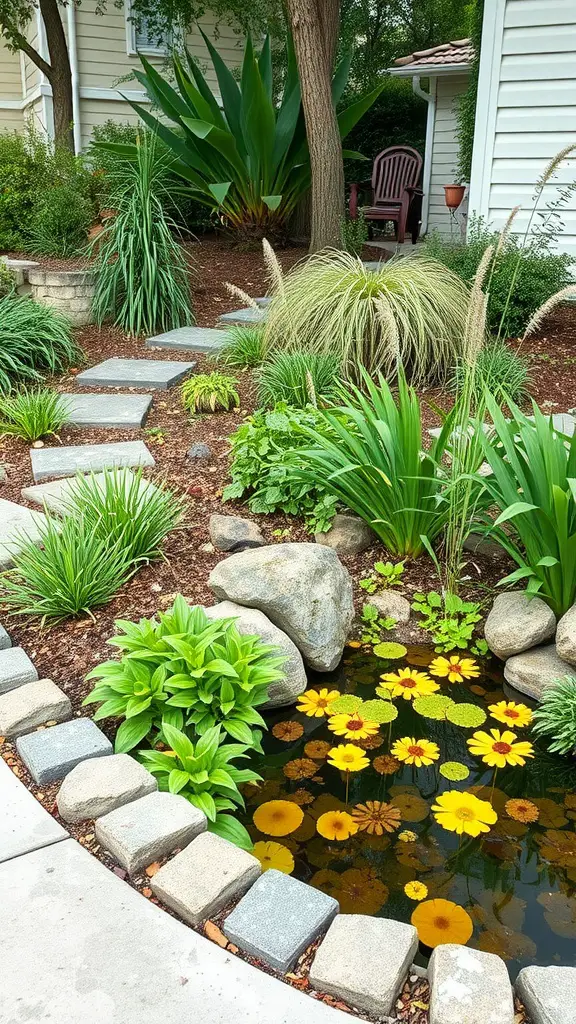
Rain gardens offer an intelligent solution for stormwater management and enhance your property’s aesthetics. The picture displays a beautifully crafted rain garden, situated among lush greenery and a delightful pond. This design effectively collects rainwater and creates a haven for native animals.
Rain gardens thrive with native plants, like those surrounding this pond. These species are typically drought-resistant and need less watering. Their vibrant greenery provides appealing textures and colors, enhancing the garden’s beauty.
Adding stones around your pond improves drainage and provides a natural aesthetic. This design is both practical and creates a peaceful retreat in your garden. Furthermore, floating flowers add vibrant color, attract pollinators, and boost local biodiversity.
Creating Xeriscape Gardens for Water Efficiency
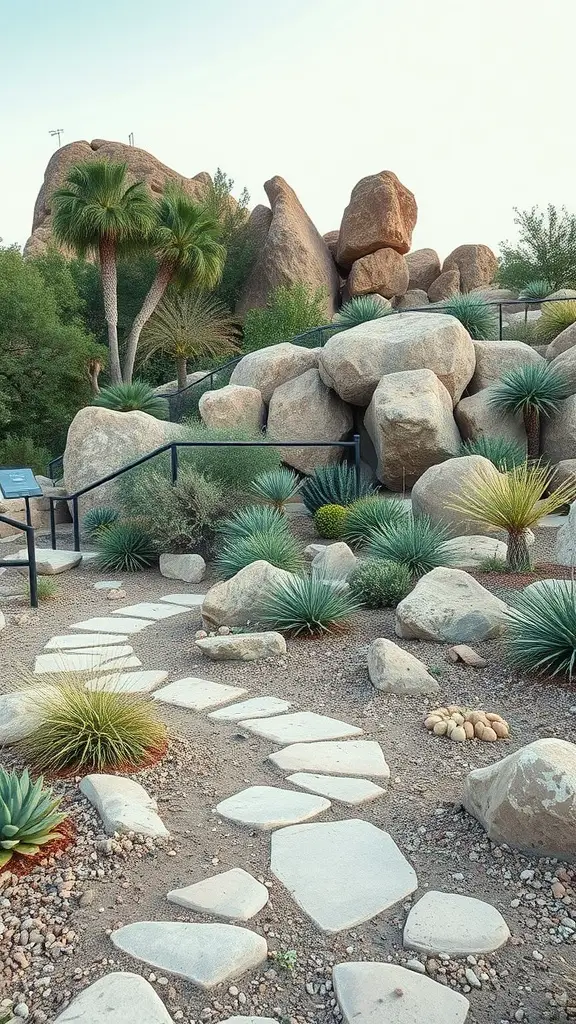
Xeriscaping offers an excellent approach to garden design, significantly reducing water consumption. The featured image showcases a stunning xeriscape garden. It incorporates diverse, drought-resistant plants and a charming natural stone path. This design conserves water and elevates the visual beauty of your landscape.
Utilizing sizable rocks and resilient flora, such as succulents and palms, establishes a distinctive, drought-tolerant landscape. Observe the strategic placement of stones, crafting a pathway. This directs garden visitors and introduces visual depth and tactile appeal.
Landscapes become captivating by blending diverse textures, like sleek stones and sharp-leaved plants. The verdant foliage nestled among the rocks injects vitality, demonstrating the remarkable adaptability of plants thriving in water-scarce environments. This design approach, popular in 2025, enhances visual appeal and promotes sustainable gardening.
This garden showcases smart water conservation in an appealing design. Select the correct plants and materials to build a functional and beautiful landscape. It’s ideal for anyone wanting a more sustainable way of life.
Selecting Drought-Resistant Trees for Shade
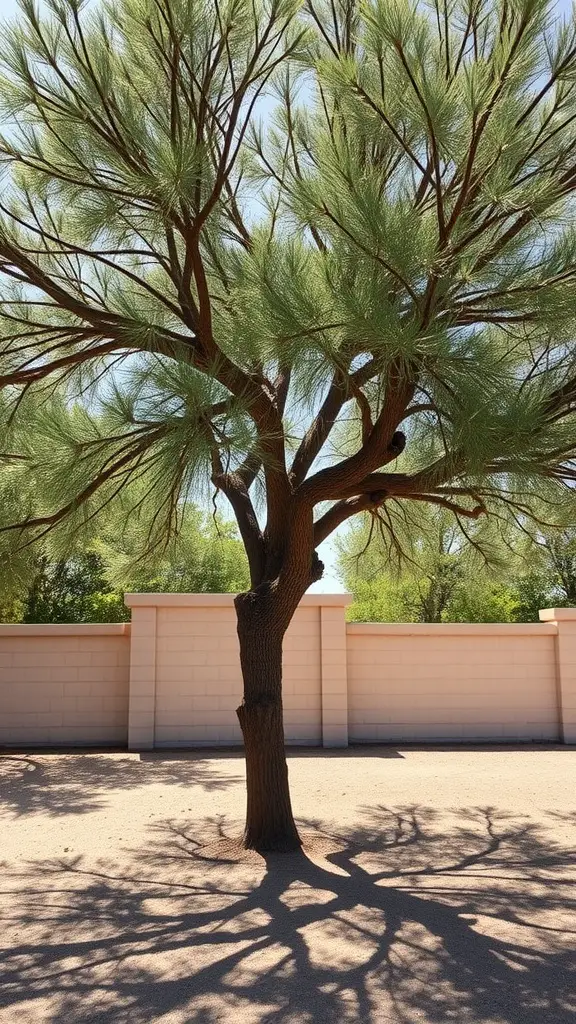
Selecting appropriate trees is key for a water-wise landscape design. This image features a stunning drought-tolerant tree, providing both shade and aesthetic appeal. Its delicate branches extend outwards, forming a beautiful canopy and projecting captivating shadows onto the earth.
These resilient, drought-resistant trees offer beauty and practicality. They flourish with minimal water, reducing upkeep and conserving vital resources. In warmer regions, they offer refreshing shade, lowering temperatures around your outdoor areas.
When choosing a tree, think about its full-grown size and how it grows. The tree pictured shows how a properly positioned tree improves your yard and offers shade. Furthermore, trees like this draw in local animals, bringing your garden to life.
Choosing drought-tolerant trees is a wise decision for a sustainable and beautiful landscape in 2025. Select the right varieties, and your garden will thrive with minimal water consumption.
Designing with Succulents for Low Maintenance

Succulents remain a top pick for modern landscaping, particularly for those seeking easy upkeep. Their diverse forms, hues, and dimensions offer adaptability for any setting. This image highlights a collection of succulents, illustrating their potential to craft dynamic and flourishing gardens. Consider them for your 2025 garden design!
These resilient plants excel in arid environments. This makes them ideal for water-wise gardens. The image showcases a beautiful blend of diverse textures and vibrant hues. Notice the cheerful interplay of green, pink, and yellow layers, creating a welcoming ambiance.
For eye-catching succulent arrangements, group plants by color or form. Combine large, rosette-shaped succulents with smaller, spiky types to create visual interest. Incorporating rocks or gravel will boost the natural aesthetic and improve drainage.
Succulents also shine with their low watering needs. This saves you valuable time and helps conserve water, making them a sustainable choice. With minimal attention and proper sunlight, you can cultivate a thriving succulent garden.
Designing Terraced Gardens to Prevent Erosion
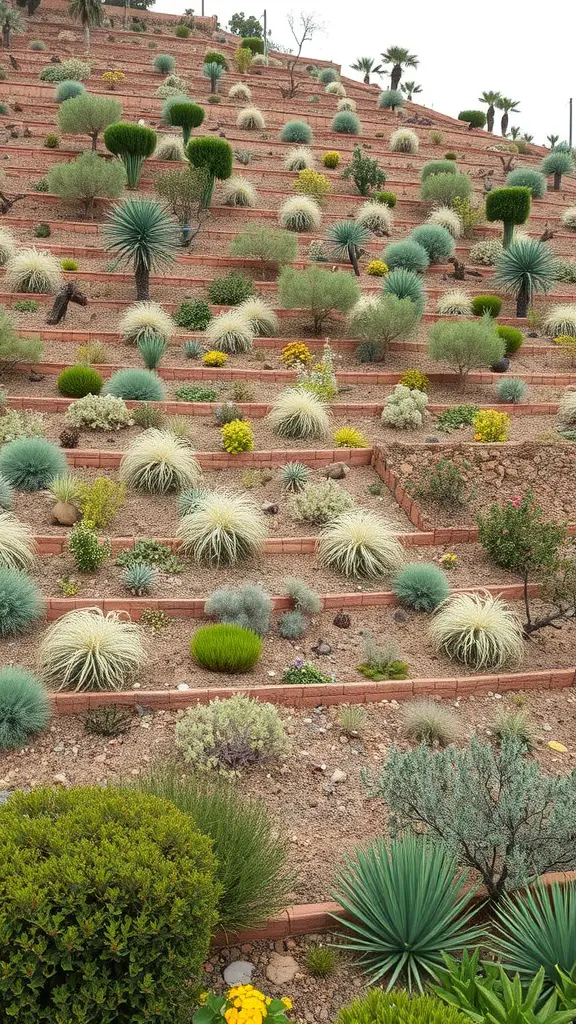
Terraced gardens offer an intelligent solution for managing sloping terrains. This image showcases a stunning terraced garden, highlighting diverse, water-wise plants. The terrace steps effectively reduce water runoff, crucial for preventing soil erosion.
Retaining walls provide essential structure and clearly define planting zones. These walls stabilize the soil, promoting healthy plant growth by preventing nutrient loss. Observe the strategic plant placement; diverse textures and colors create visual appeal while fulfilling a functional role.
Choosing the correct plants is key for a water-wise garden. Succulents, cacti, and native bushes are excellent options. They need very little water and thrive in dry climates. This garden features a blend of these plants, offering beautiful scenery and promoting environmental responsibility.
Terracing offers another significant advantage: the creation of microclimates. Certain sections might experience increased sunlight or shade. This variation enables a wider variety of plants to thrive. Consequently, the garden’s aesthetic appeal is heightened, and biodiversity is encouraged.
In 2025, terraced gardens remain a top choice. They effectively stop soil erosion. Plus, they create a more beautiful and easier-to-maintain outdoor area.
Utilizing Drip Irrigation Systems for Efficient Water Use
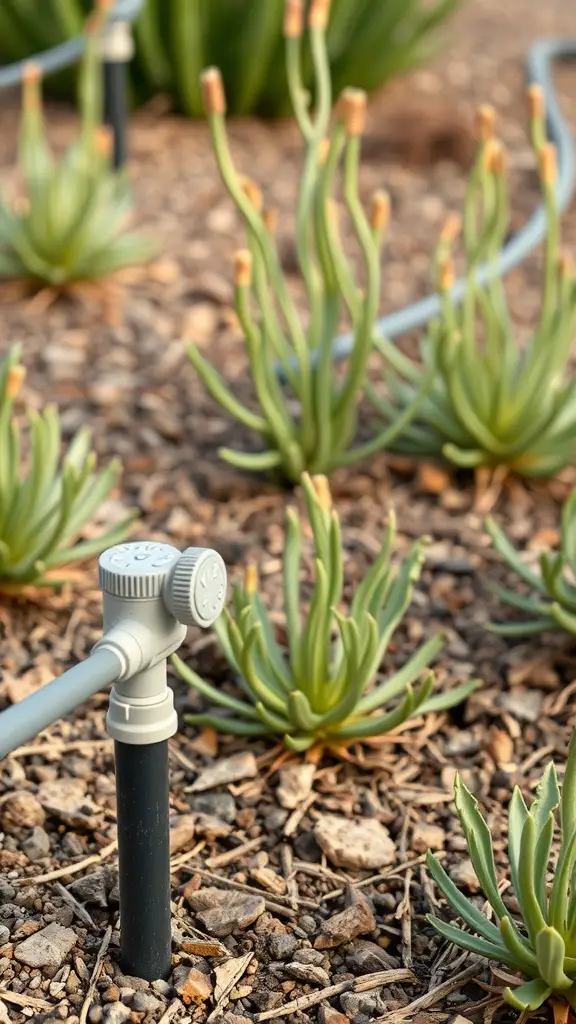
Drip irrigation is an excellent solution for water-wise landscaping. The photo showcases a drip emitter in a succulent garden. This efficient system targets water directly to plant roots, maximizing water usage.
These advanced irrigation solutions boost efficiency and significantly conserve water. Precise targeting of plants minimizes waste and encourages robust growth. As seen in the image, succulents flourish with this focused watering approach, perfectly adapted to arid environments.
Installing a drip irrigation system is now simpler than ever. Just arrange the tubing and connect emitters close to each plant. Easily customize the water flow for various plant types. This makes it a flexible choice for any garden layout in 2025.
In 2025, drip irrigation perfectly aligns with drought-resistant landscaping. It allows you to have a stunning garden while conserving water. With some initial planning, you can create a thriving, sustainable landscape.
Creating Focal Points with Drought-Tolerant Sculptures
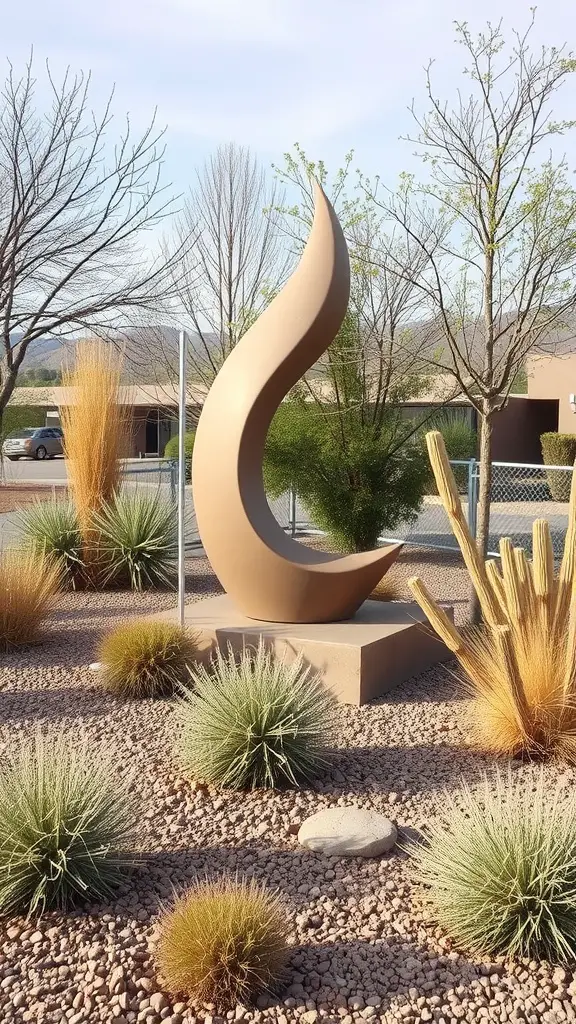
Sculptures elevate drought-resistant gardens, turning them into captivating outdoor areas. This photo features a modern sculpture standing tall among hardy, water-wise plants. Its elegant form and natural colors provide a striking contrast against the lush foliage, forming a beautiful centerpiece.
Sculptures enhance landscapes with unique character and charm. They offer a break from typical greenery and stone, sparking visual intrigue. Here, the sculpture’s vertical presence naturally guides the viewer’s gaze upward. This creates a pleasing equilibrium with the surrounding, shorter plants.
Opt for sculptures that mirror your personal taste or the garden’s central themes. Abstract, geometric, or nature-inspired art can elevate your outdoor area. Best of all, they need very little upkeep.
Incorporating Gravel and Rock Elements for Texture

Gravel and rock are key to stunning, drought-resistant landscapes. They introduce unique textures that elevate the design. This image features a curved path of fine gravel. It’s edged with larger rocks and lush, drought-tolerant plants. This combination is both beautiful and practical for water conservation.
The gentle curves of the walkway encourage exploration and lead visitors through the scenery. The smooth gravel contrasts beautifully with the rugged, natural rock, adding visual interest. This approach is excellent for saving water, as gravel helps the soil stay moist and reduces water loss.
Adding rocks of varying sizes and colors enhances visual appeal. For example, reddish-brown mulch around the rocks beautifully complements the green plants. This creates a unified and attractive outdoor space. It’s a simple, yet impactful design choice.
Remember to choose local, drought-resistant plants. Combining them with gravel and rock features boosts your landscape’s appeal. Plus, it ensures a sustainable and easy-to-care-for yard in 2025.
Designing Outdoor Living Spaces with Drought Resistance
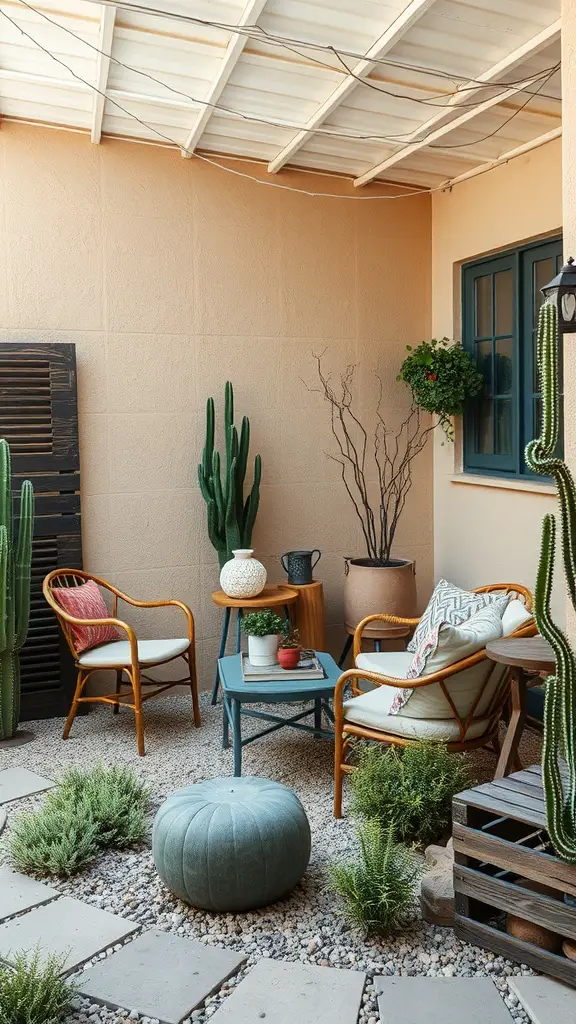
Designing attractive and drought-tolerant outdoor areas is a wise decision for homeowners. It helps reduce water consumption and increases outdoor enjoyment. The picture showcases a comfortable patio, highlighting key features of this eco-friendly design.
This area offers cozy seating, ideal for relaxation or hosting guests. Natural elements, such as wood and stone, amplify the design’s organic ambiance. Cacti and drought-resistant plants introduce greenery and ensure easy garden upkeep.
This patio’s design prioritizes functionality. A gravel base ensures excellent drainage, preventing standing water. This is key for drought-tolerant landscaping. Comfortable elements, such as the plush pouf and colorful cushions, add style and relaxation to the space.
Adding shaded areas significantly enhances the usability of outdoor spaces, particularly in hot climates. The canopy shown offers an ideal way to enjoy the outdoors while remaining cool and comfortable. The blend of comfort and thoughtful plant selection creates a relaxing and eco-friendly environment. It demonstrates how easily you can combine stylish design with environmental responsibility in 2025.
Integrating Edible Plants into Drought-Tolerant Landscapes
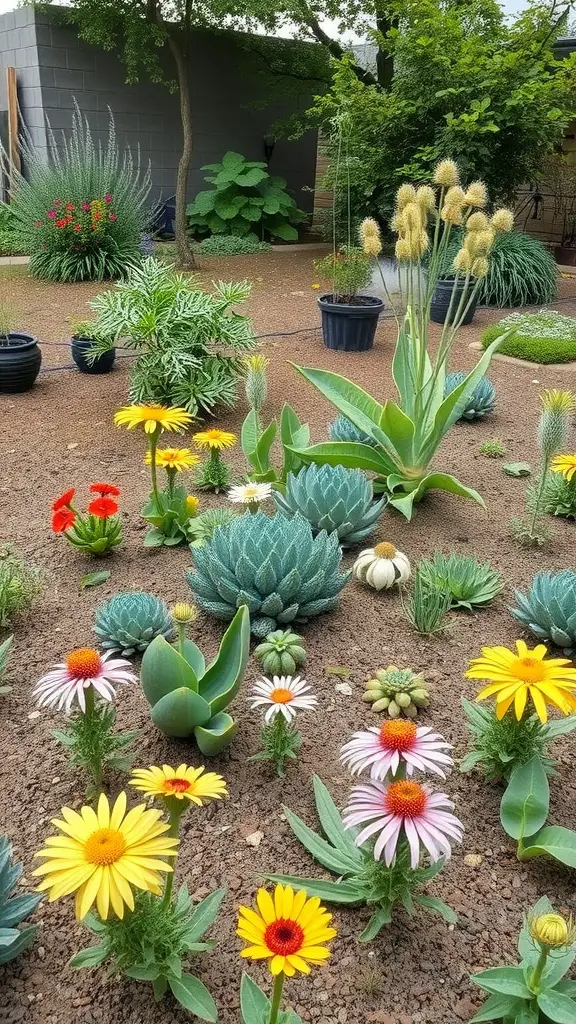
Water-wise gardens rival traditional landscapes in beauty and yield. This image displays a lively assortment of plants, perfect for arid climates and your kitchen. Observe the blend of blooms and succulents. These plants demand minimal water and upkeep, making them excellent choices for sustainable gardening in 2025.
Enhance your garden by integrating edible plants such as agave or various herbs. This approach adds fresh flavors to your meals and promotes garden sustainability. Agave, for instance, provides delicious syrup. Bright, colorful flowers also draw in pollinators, which greatly improves the health of your entire garden.
Begin by selecting plants suited to your local climate. Native herbs are a great choice, as they often flourish even with minimal water. Enhance the visual appeal by adding vibrant flowers. This method transforms your space and offers fresh ingredients readily available.
Remember to consider seasonal shifts when planning. Certain plants flourish in spring, while others excel in summer. This ensures a vibrant and productive garden year-round. Incorporating edible plants into your water-wise designs introduces a spectrum of tastes and hues, offering both practicality and beauty.
Using Color Theory in Drought-Tolerant Landscaping

Creating a lively drought-resistant garden? Color theory is key. This image displays a vibrant mix of orange, purple, yellow, and white flowers. Each color enhances the garden’s beauty and creates a balanced feel.
Vibrant hues draw attention and create an inviting garden space. Here, the mix of daisies, flowering succulents, and bright gerberas establishes an energetic ambiance. Drought-tolerant plants frequently boast bold colors. This enhances the landscape and offers visual appeal while conserving water.
Employing color contrast remains a clever strategy in 2025. Imagine vibrant purple lupines sharply contrasting with sunny oranges and yellows, crafting a lively visual. This immediately captures the eye and emphasizes each plant’s distinct texture.
Furthermore, arranging plants by color generates a captivating centerpiece. Picture a garden where brilliant reds blend with cheerful yellows, forming a spectrum of color. These layouts can enhance your outdoor area, making it feel larger and more welcoming in 2025.
In conclusion, applying color theory to drought-resistant landscaping enhances beauty and promotes sustainability. Whether you’re planting colorful blooms or distinctive succulents, remember that your color choices are impactful.
Implementing Seasonal Plant Rotation for Diversity
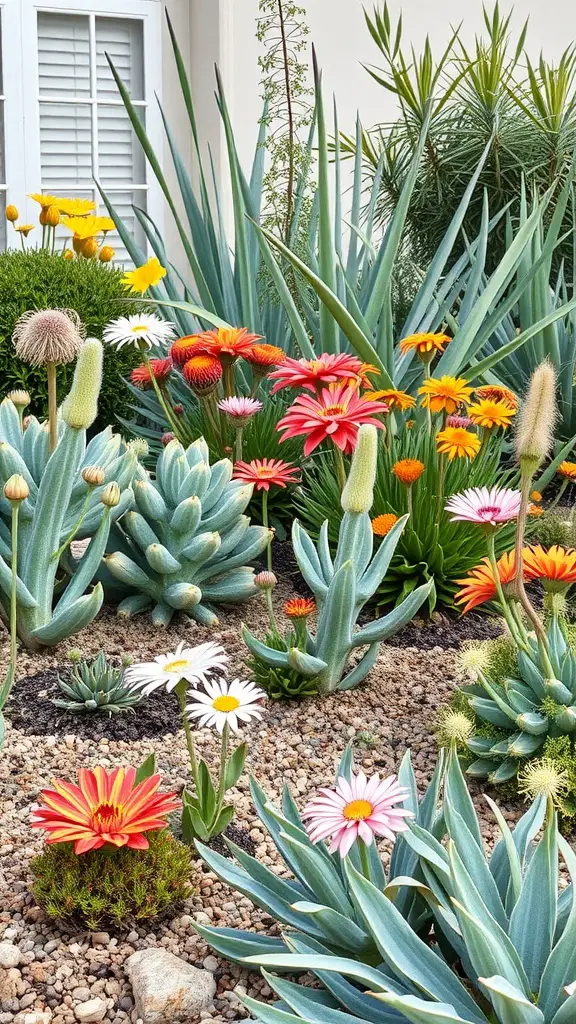
Crafting a water-wise garden? Consider seasonal plant rotation. This ensures year-round beauty and supports a healthy ecosystem. The picture displays a stunning array of drought-tolerant species. Notice how diverse colors and textures create a visually pleasing and balanced landscape.
Keep your garden vibrant all year by strategically rotating plants with varied bloom times. Notice how the colorful flowers in front draw in essential pollinators. Meanwhile, the hardy succulents in the back offer a strong foundation and visual interest.
This strategy enhances your landscape’s appeal and aids local wildlife. Diverse plantings create a flourishing habitat for birds, bees, and butterflies, boosting your garden’s ecosystem.
Seasonal crop rotation is key for healthy soil. Different plants need different nutrients. This reduces soil depletion and promotes sustainable gardening. Combine flowering plants with varied water needs. Some will flourish in dry conditions, while others thrive when it’s wet.
Incorporating Water Features for Artistic Appeal

Water elements introduce captivating allure to drought-resistant gardens. The picture showcases a beautiful pond bordered by natural stone. A soft fountain enhances the scene with motion and sound, fostering a tranquil ambiance.
Adding these elements boosts your garden’s beauty and helps local animals. Water features draw birds and butterflies, enlivening your outdoor space. Rocks and native plants create a natural aesthetic while saving water.
As you plan your 2025 landscape design, carefully consider where to place your water feature. It can be a stunning centerpiece or naturally integrate with your plants. The color and texture of your chosen stones significantly impact the atmosphere.
In 2025, integrating a water feature remains a stylish upgrade for any drought-resistant garden. It creates a tranquil retreat and supports a thriving local environment. Consider exploring designs that match your personal taste and financial plan.
Emphasizing Vertical Gardens to Maximize Space
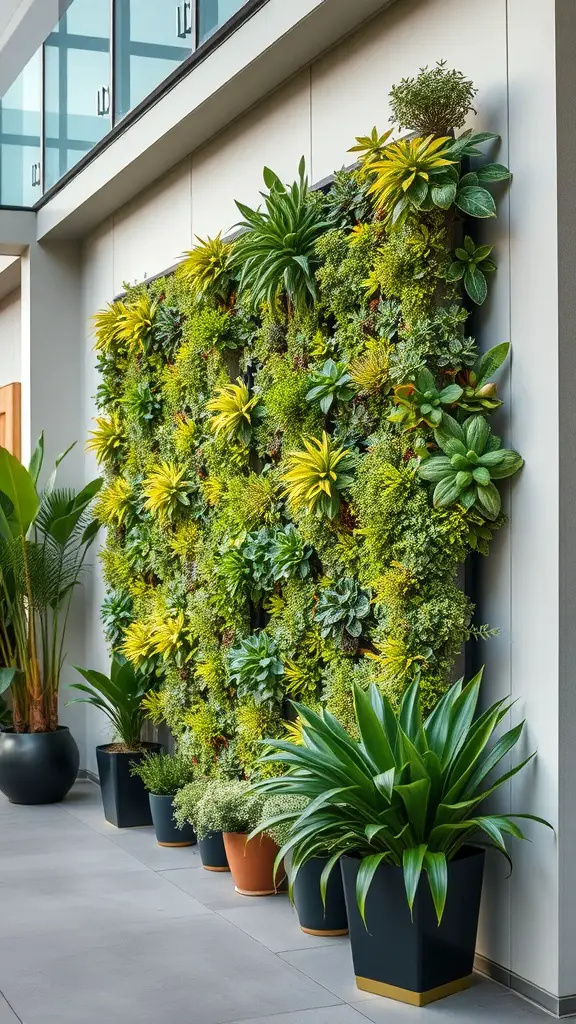
Vertical gardens are an innovative solution for drought-resistant landscaping, maximizing space in style. The picture showcases a vibrant green wall, filled with diverse plants suited for dry climates. This design conserves ground area and brings a refreshing touch of nature to plain walls.
Living walls are ideal for compact spaces. They enable the cultivation of diverse, low-water plants without large gardens. This design features a mix of green and yellow hues, plus varied textures, adding visual appeal and life.
These gardens offer more than just beauty. They improve air quality and insulate buildings effectively. The featured plants are resilient and need little upkeep. This makes them perfect for those seeking greenery with minimal effort.
Placing planters at the bottom expands plant variety. This tiered design boosts visual charm and supports a thriving ecosystem. Vertical gardens offer a functional and fashionable choice for maximizing your outdoor area in 2025.
Creating Pathways with Drought-Resistant Ground Covers

Landscaping pathways enhance visitor experience and boost aesthetic appeal. In 2025, drought-resistant designs prioritize suitable materials and plant choices. This image showcases a tranquil stone slab pathway, perfectly complemented by vibrant green plants.
The ground cover beside the path is probably drought-tolerant. This selection improves the path’s appearance and reduces water consumption. Hardy grasses and low plants flourish here, creating a welcoming, gentle feel.
Crafting your garden paths? Opt for natural stone or gravel. These materials harmonize with nature and endure sunlight. They also demand less upkeep. Combine them with hardy ground covers. This ensures your pathway remains lively and low-maintenance.
Consider your yard’s layout. A winding path, similar to the one pictured, encourages discovery and links various garden zones. Adding drought-resistant plants alongside the path elevates the experience and creates a stunning visual setting.
Creating Wildlife Habitats with Native Plants

This lively image showcases stunning native flowers bursting with color. A butterfly gracefully flits among them, creating a picturesque scene. These vibrant blooms enhance the landscape and are vital for a healthy local ecosystem.
Creating wildlife habitats is easy with native plants in your landscape. These plants thrive in the local climate. They need less water and care compared to non-native options. Adding them to your garden attracts helpful insects and pollinators. Expect to see butterflies, bees, and birds flourish!
This butterfly exemplifies the vibrant beauty native plants offer to gardens. Cultivating a garden with indigenous flora not only elevates your personal enjoyment but also provides crucial support for local wildlife populations. Consider planting native species to create a thriving ecosystem.
Consider choosing diverse native flowers. Select varieties that bloom at different times. This keeps your garden vibrant. It also provides a continuous food source for local wildlife all year round.
Using Decorative Boulders for Natural Beauty

Boulders are a fantastic way to elevate your outdoor space into a tranquil retreat. The photo showcases a textured landscape featuring diverse rocks and minimal plant life. This organic aesthetic is both beautiful and functional.
These substantial rocks define the garden’s layout. They establish distinct levels and visual interest, naturally directing your gaze. The varied dimensions and forms of the stones inject personality, giving the landscape a vibrant and engaging feel.
Furthermore, boulders are vital for drought-resistant landscaping. In areas with scarce water, they aid in soil moisture retention. Boulders also generate shaded zones, which benefit nearby plants. This ensures your landscape flourishes, even during droughts.
It’s easy to add these features. Select rocks that match your taste and the local scenery. Position them carefully with native plants. This creates a stunning, easy-care landscape. It also boosts the natural appeal of your property.
Designing with Seasonal Interest in Mind
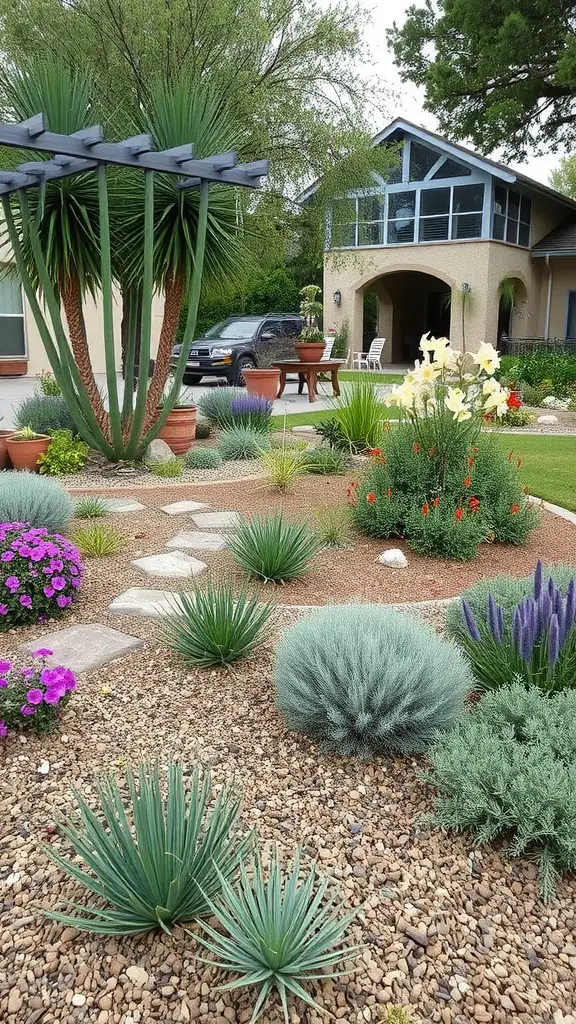
A drought-resistant landscape needs year-round appeal. This ensures your yard remains beautiful in every season. The featured garden exemplifies this concept flawlessly. It uses colorful blooms and interesting leaves to create a dynamic and engaging outdoor space.
Our garden showcases diverse flora, carefully selected for year-round visual appeal. Vibrant purple petunias and stately lilies offer a striking contrast against the natural gravel backdrop. This deliberate combination enhances aesthetics and supports local pollinators, fostering a thriving ecosystem.
Strategic plant selection is key for adapting to seasonal shifts. Succulents, with their unique shapes, offer visual appeal year-round, even after flowering. Their resilience and low water requirements make them ideal for water-wise gardens. Replacing lawns with rocks and gravel simplifies upkeep and elevates the garden’s design.
Stone pathways guide you through the garden, sparking curiosity. The layout encourages exploration and appreciation of nature’s charm. Select plants offering year-round visual appeal. This creates a landscape that’s both practical and stunning.
Xeriscaping Principles for Water Efficiency
Xeriscaping focuses on creating water-efficient landscapes. This image showcases a xeriscape garden with drought-resistant plants and stone paths. The plants are selected to flourish in dry climates, ensuring a beautiful and sustainable design. This approach combines aesthetics with water conservation.
The curved walkway beckons you to explore. Gravel and stone paths help plants stay hydrated and offer easy upkeep. Cacti mixed with bright green plants create visual interest and pops of color, boosting the garden’s beauty.
This garden design emphasizes the use of indigenous flora. These plants need less irrigation and thrive in the regional environment. This approach conserves water and benefits native animal species. The addition of stones and ground cover minimizes moisture loss. This creates a sustainable and aesthetically pleasing outdoor space.
In 2025, this image perfectly embodies xeriscaping’s core idea. It highlights how smart design creates beautiful, sustainable gardens. By embracing these methods, anyone can build a water-wise landscape. It will flourish while using minimal water.